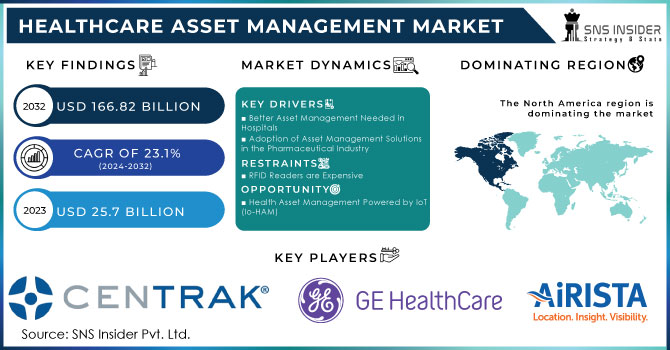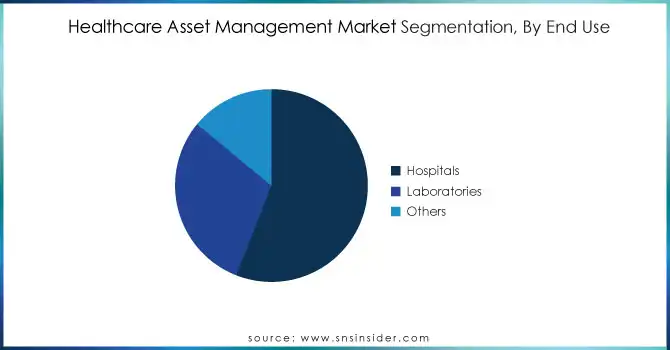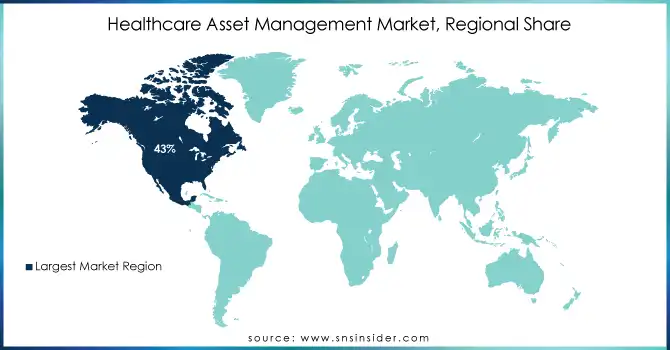Healthcare Asset Management Market Size Analysis & Trends:

Get more information on Healthcare Asset Management Market - Request Sample Report
The Healthcare Asset Management Market size was valued at USD 25.7 billion in 2023, and is expected to reach USD 166.82 billion by 2032 and grow at a CAGR of 23.1% over the forecast period 2024-2032.
The healthcare asset management market is growing at a significant growth rate with an increasing need for effective asset-tracking solutions in healthcare facilities. For 2023, the U.S. spent $4.9 trillion in healthcare, which accounted for 17.6% of the Gross Domestic Product of the country, according to the latest government data. Such a huge investment in health care emphasizes the need for optimum asset management to maximize resource utilization and improve operational efficiency. The emphasis on healthcare expenditure has always increased in India. National Health Account estimates for the financial years 2020-21 and 2021-22 suggest that there is a steady increase in government health expenditure. The large growth can be attributed to increases in demand for real-time location tracking of medical equipment, the use of RFID and RTLS technologies, and inventory management systems. The COVID-19 pandemic has also accentuated the need for asset management solutions, especially in healthcare facilities which were inundated by medical equipment needed to fight the pandemic and ensure their accessibility at the exact point of view of need.
Moreover, government programs targeting the enhancement of healthcare infrastructure and the minimization of operating costs have propelled the market forward. However, in the U.S., the Department of Health and Human Services encourages the use of asset management systems in hospitals and clinics, which have proven to advance patient outcomes and help with operational efficiency. Moreover, rising emphasis on patient safety along with stringent regulatory requirements are encouraging healthcare providers to adopt advanced asset management solutions. Technological advancements have also been fueling the market due to the ability of our asset management platforms to integrate Artificial Intelligence and machine learning algorithms and provide predictive maintenance functions and resource capacity optimization.
Market Dynamics
Drivers
-
Healthcare facilities are increasingly adopting asset management solutions to optimize resource use, reduce equipment search times, and achieve cost savings.
-
The integration of IoT devices and AI-driven platforms enhances real-time tracking and predictive maintenance, improving operational efficiency in healthcare settings.
One of the major drivers for the healthcare asset management market is efficient resource utilization, which helps hospitals and clinics improve their operational workflows while minimizing the cost of operation. With both medical devices and various equipment proliferating in our healthcare environments, being able to find and keep track of critical assets becomes a larger challenge. Studies reveal that healthcare staff spends an estimated 30-40 minutes per shift searching for misplaced equipment, highlighting a pressing need for effective asset-tracking solutions. Advanced asset management systems such as Real-Time Location Systems (RTLS), Radio Frequency Identification (RFID), and IoT-based technologies make it easy to track assets effortlessly in real-time. One example is that of Mount Sinai Hospital, where they implemented an IoT-enabled tracking system and were able to cut equipment search times in half this helped them to ensure that staff was able to provide patients with the very critical care they needed, and also, helped with an increase in productivity along with staff time.
Furthermore, resource optimization plays a pivotal role in preventing equipment downtime. Predictive maintenance enabled by AI-driven asset management tools identifies potential issues before they escalate, minimizing disruptions. In 2023, a healthcare facility in the UK leveraged AI-enabled asset tracking to reduce equipment failure rates by 25%, improving operational efficiency and enhancing patient outcomes. With the increasing adoption of these technologies, the ability to utilize existing resources efficiently is becoming critical in the modern healthcare environment.
Restraints:
-
The initial investment for deploying advanced asset management systems can be substantial, potentially deterring smaller healthcare facilities from adoption.
-
Inaccurate data collection methods can lead to incorrect assessments of resource needs, impacting the performance and decision-making processes within healthcare
The factor limiting the growth of the healthcare asset management market is the high cost of implementation of technologically advanced asset management systems. The first step towards maintaining advanced supply chain solutions involves a considerable investment of initial capital for acquiring and integrating modern technologies such as IoT devices, RFID tracking, and AI-powered platforms. This presents a challenge, particularly for smaller healthcare facilities or organizations that typically operate on a restricted budget. These systems not only require upfront costs for hardware and software but also demand ongoing maintenance, training, and system updates, further adding to the financial burden. Additionally, the complexity of deploying these technologies within existing healthcare IT infrastructures can incur hidden costs related to integration efforts, downtime, and resource allocation. The return on investment (ROI) from these systems may take time to materialize, making it difficult for smaller institutions to justify the initial outlay. As a result, many healthcare organizations may delay or forgo adopting asset management systems, hindering overall market growth.
Healthcare Asset Management Market Segmentation Analysis
By product
In 2023, the RFID segment led the market and accounted for over 64% of the share of global revenue. This dominance is due to the benefits of using RFID technology in healthcare asset management. Another advantage of RFID is that RFID enables real-time tracking and monitoring of medical equipment, supplies, and even patients, helping healthcare facilities gain greater operational efficiency and cost savings. The U.S. Food and Drug Administration (FDA) states that RFID technology has demonstrated considerable promise in assisting with enhancing patient safety and minimizing the dangers related to medication errors. The FDA has begun to promote RFID use for healthcare, especially for tracking drugs and medical devices. B) It also leads the market share because of government initiatives regarding RFID in the healthcare sector. For example, the Centers for Medicare & Medicaid Services (CMS) has developed initiatives that provide incentives for hospitals to utilize RFID technology for asset tracking and inventory management. From small clinics to large hospital networks, healthcare providers are showing a sharp interest in RFID solutions and it is mainly because of the cost-effectiveness and scalability features. Furthermore, the potential for RFID systems to integrate with current Hospital Information Systems and electronic medical records has also contributed to their growth in the healthcare industry.
By Application
The hospital asset management segment accounted for the highest market share in 2023. The large share of this segment can be ascribed to the growing complexity involved in hospital processes, as well as the high demand for effective management of medical equipment, supplies, and resources. There are more than 6,000 hospitals in America, according to the American Hospital Association, each with thousands of assets to manage daily. Hospitals have a huge number of equipment and supplies that need good asset management, to utilize them effectively and cut down the cost of operations. Furthermore, governments have compelled healthcare systems to function efficiently and productively, which has a huge impact on the acceptance of asset management systems in a hospital environment. For example, the Joint Commission, which accredits and certifies healthcare organizations in the United States, has established standards for equipment maintenance and management that hospitals must meet to maintain their accreditation. These standards have prompted hospitals to invest in comprehensive asset management solutions. Additionally, the U.S. Department of Health and Human Services is pursuing programs to encourage the use of asset management systems in hospitals as part of a broader push to improve quality and lower costs associated with care. Hospital asset management systems are becoming an integral part of modern healthcare hospitals as they help enhance patient care by ensuring the availability of critical equipment, reduced wait times, and overall operational efficiency.
By End Use
The hospitals segment dominated the market with the largest market share of 58% In 2023. Several reasons contribute to this dominance, such as the magnitude and complexity of hospital operations, the high asset volume managed by hospitals, and the criticality of healthcare delivery in these institutions. According to historical data from the American Hospital Association, U.S. hospitals admitted over 36 million patients and performed over 108 million outpatient visits in 2019. This large patient volume requires the effective management of a wide range of medical equipment, supplies, and resources. The adoption of asset management systems in hospitals has also been fueled by government regulations and initiatives. One example is the Hospital Value-Based Purchasing Program, implemented by the Centers for Medicare & Medicaid Services (CMS), which links hospital payment to performance on quality measures, including resource use and efficiency. As a result, this program has incentivized hospitals to spend on advanced asset management solutions to utilize their resources effectively and optimize their operations. Additionally, the Office of the National Coordinator for Health Information Technology (ONC) has promoted the adoption of health IT systems, including asset management solutions, as part of its efforts to improve healthcare quality and reduce costs. The ability of asset management systems to enhance patient safety, reduce equipment downtime, and improve regulatory compliance has made them essential tools for hospitals seeking to maintain their competitive edge in an increasingly complex healthcare landscape.

Regional Analysis
In 2023, North America accounted for 43% share of the global healthcare asset management market. The region has a developed healthcare infrastructure, high adoption of innovative technologies, and beneficial government measures, these factors may contribute to the leadership position. With support for programs and incentives from the U.S. Department of Health and Human Services that focus on the importance of asset management systems for healthcare facilities, the movement to make the U.S. healthcare system more cost-effective and efficient is gaining attention. As an example, the Office of the National Coordinator for Health Information Technology (ONC) has incorporated asset management functionalities in its requirements for certified electronic health record technology to incentivize healthcare providers to adopt these solutions.
However, the Asia Pacific region is expected to witness the fastest growth, with a significant CAGR during the forecast period. Rapid growth is being fuelled by a developing healthcare infrastructure, rising adoption of digital technologies in the growing healthcare sector, and high growth potential in emerging economies. The market is being significantly augmented by government efforts in nations like China and India. Take for example the "Healthy China 2030" plan from China, aiming to reform the national health system and reform healthcare technology, infrastructure, and cost control strategy. India has also taken the lead with its National Digital Health Mission, which encourages digital health solutions, including asset management systems, in different parts of its healthcare landscape. An increase in affordability and improved knowledge of healthcare asset management benefits is also playing a vital role in the quick growth of the Asia Pacific market.

Need any customization research on Healthcare Asset Management Market - Enquiry Now
Recent developments:
-
TRIMEDX, a clinical asset management company, released the healthcare-specific, real-time location system (RTLS) called GeoSense in April 2024. With this advanced system, medical facilities can enhance their asset management processes by providing accurate tracking for medical devices.
-
GE Healthcare launched ReadySee, a solution for asset management and network supervision, in April 2023. Specifically, ReadySee transforms device and infrastructure data into insights to enable healthcare professionals to find devices, reduce manual processes, and streamline cybersecurity management through device vulnerability identification.
Key Players
Key Service Providers/Manufacturers
-
Zebra Technologies (Zebra MotionWorks, ZT600 Series)
-
GE Healthcare (AssetPlus, GE Healthcare’s Medical Equipment Management)
-
Siemens Healthineers (Real-Time Location Services, Asset Management Solutions)
-
Impinj (Impinj Speedway, Impinj xSpan)
-
Stanley Healthcare (Stanley Healthcare MobileView, AeroScout)
-
Oracle Corporation (Oracle Healthcare Cloud, Oracle Asset Tracking)
-
Savi Technology (Savi Mobile, Savi Asset Tracking)
-
Kipp & Zonen (Coriolis System, Smart Asset Tracker)
-
TAGSYS (Active RFID, RTLS Solution)
-
Honeywell (Honeywell RTLS, Vocollect)
Key Users
-
Johns Hopkins Medicine
-
Cleveland Clinic
-
Mayo Clinic
-
Kaiser Permanente
-
HCA Healthcare
-
Mount Sinai Health System
-
Medtronic
-
St. Jude Children's Research Hospital
-
NewYork-Presbyterian Hospital
-
Baylor Scott & White Health
| Report Attributes | Details |
|---|---|
| Market Size in 2023 | USD 25.7 Billion |
| Market Size by 2032 | USD 166.82 Billion |
| CAGR | CAGR of 23.1% From 2024 to 2032 |
| Base Year | 2023 |
| Forecast Period | 2024-2032 |
| Historical Data | 2020-2022 |
| Report Scope & Coverage | Market Size, Segments Analysis, Competitive Landscape, Regional Analysis, DROC & SWOT Analysis, Forecast Outlook |
| Key Segments | • By Product (Radiofrequency Identification Devices (RFID) {Tag Passive Tags [Ultra-high frequency, Readers/Interrogators, Antennas] Accessories Hardware, Services, Software}, Real-Time Location Systems (RTLS) {Hardware [Tags/Badges, Readers/Interrogators], Software, Services}) • By Application (Pharmaceutical Asset Management {Drug Anti-counterfeiting, Supply Chain Management}, Hospital Asset Management {Equipment Tracking and Management, Patient Management, Temperature and Humidity Control, Staff Control, Infection Control and Hand Hygiene Compliance}) • By End Use (Hospitals, Laboratories, Others) |
| Regional Analysis/Coverage | North America (US, Canada, Mexico), Europe (Eastern Europe [Poland, Romania, Hungary, Turkey, Rest of Eastern Europe] Western Europe] Germany, France, UK, Italy, Spain, Netherlands, Switzerland, Austria, Rest of Western Europe]), Asia Pacific (China, India, Japan, South Korea, Vietnam, Singapore, Australia, Rest of Asia Pacific), Middle East & Africa (Middle East [UAE, Egypt, Saudi Arabia, Qatar, Rest of Middle East], Africa [Nigeria, South Africa, Rest of Africa], Latin America (Brazil, Argentina, Colombia, Rest of Latin America) |
| Company Profiles | Zebra Technologies, GE Healthcare, Siemens Healthineers, Impinj, Stanley Healthcare, Oracle Corporation, Savi Technology, Kipp & Zonen, TAGSYS, Honeywell. |
| Key Drivers | • Healthcare facilities are increasingly adopting asset management solutions to optimize resource use, reduce equipment search times, and achieve cost savings. • The integration of IoT devices and AI-driven platforms enhances real-time tracking and predictive maintenance, improving operational efficiency in healthcare settings. |
| Restraints | • The initial investment for deploying advanced asset management systems can be substantial, potentially deterring smaller healthcare facilities from adoption. • Inaccurate data collection methods can lead to incorrect assessments of resource needs, impacting the performance and decision-making processes within healthcare |

